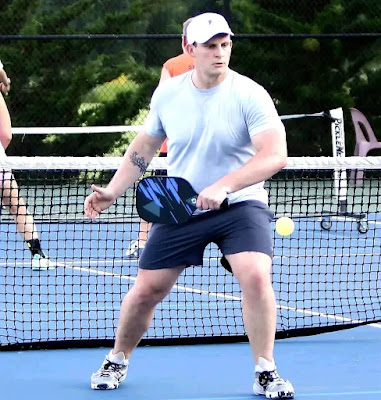“Setting up the point” in pickleball | Benefit & Strategies
In the game of pickleball, the concept of “setting up the point” pertains to skillfully planning and executing shots and tactics to shape a favorable situation. This situation empowers you or your team to lead the rally and eventually secure the point. This process involves a variety of shots, clever ball placement, and well-timed movements to influence your opponent's position, capitalize on their weaknesses, and pave the way for winning the point on the pickleball court.
 |
| “Setting up the point” in pickleball Img credit: Dave toni |
“setting up the point” encompasses more than merely exchanging shots; it requires careful consideration, strategic thinking, and a comprehensive approach to the game. Achieving this advantage involves studying your opponent's strengths and vulnerabilities, adapting your approach accordingly, and patiently crafting the rally to gain the upper hand. Often, it entails taking an extra shot to set up a more straightforward winning opportunity, rather than solely attempting forceful plays. By effectively creating advantageous situations, your likelihood of triumphing in pickleball matches significantly increases.
Particularly, the process of "setting up the point” in pickleball holds several crucial benefits:
1. Taking Control of the Rally: By setting up the advantage, you gain the ability to determine the pace and rhythm of the game on the pickleball court. This allows you to shape the game's flow and compel your opponent to respond to your shots, effectively reversing the roles.
2. Generating Opportunities: Executing a well-thought-out advantage-building strategy can generate openings for more assertive shots or decisive plays. By manipulating your opponent's positioning, you enhance the probability of delivering a favorable shot that you can capitalize on.
3. Consistency and Patience: Establishing the advantage frequently involves employing consistent, patient shots. This approach helps you evade unforced errors. The methodical construction of the pickleball point enables you to wait for the opportune moment to seize control, thereby minimizing unnecessary risks.
4. Exploiting Weaknesses: Through keen observation of your opponent's vulnerabilities and patterns, you can strategically target specific shots or court areas to exploit these weak points. This calculated approach increases pressure on your adversary, making it more challenging for them to execute their preferred tactics.
5. Reducing Unforced Errors: Prioritizing the establishment of the advantage reduces the likelihood of hurried or poorly considered shots during the pickleball match. This results in a controlled and disciplined style of play, ultimately lowering the number of errors made in the game.
6. Building Momentum: Successfully creating advantageous situations can cultivate momentum in your favor. Skillful point construction instills confidence in your capacity to influence the game, and this positive energy can extend throughout the match.
7. Frustrating Opponents: Competent point construction has the potential to frustrate your opponents. When they struggle to identify weaknesses in your approach or counter your pickleball strategy, they might become more prone to errors or unwarranted risks.
8. Adaptability: Establishing the advantage necessitates adaptability. Being able to adjust your tactics and strategy based on your opponent's reactions keeps you engaged and effective throughout the match.
9. Teamwork in Doubles: In doubles pickleball, establishing the advantage assumes a pivotal role in teamwork and communication. Collaborating with your partner to identify opportunities and exploit opponents' weaknesses can lead to more favorable outcomes.
10. Strategic Edge: Players adept at building advantages hold a strategic edge over those who solely rely on power or athleticism. This edge enables a more versatile and effective playing style on the pickleball court.
To successfully create an advantage in pickleball, keep in mind that each shot contributes to constructing a winning opportunity. This might involve utilizing soft shots (known as dinks) to lure your opponent closer to the net, executing lobs to place the ball over their head, or maneuvering them to establish an opening for a potent shot. Each shot serves a specific purpose to lay the groundwork for a winning or attacking move.
To enhance your ability to “setting up the point” on the pickleball court, try the following five strategies:
1. Control the Tempo: Setting up the point empowers you to control the game's tempo, either by slowing it down with delicate drops and dinks or by accelerating it with powerful drives and speed-ups. This choice depends on your playing style and the relative speed of your hands and your partner's hands compared to your opponents'.
2. Create Openings: By strategically placing shots in specific areas of the court, you can create openings in your opponent's defense. This enables you to launch an attack and conclude the point with a precisely placed shot. Utilizing cross-court and sideline shots forces your opponent to cover more ground, potentially leading to winning opportunities.
3. Exploit Weaknesses: Skillful point establishment entails recognizing your opponents' strengths and exploiting any weaknesses. For instance, if your opponent struggles with their backhand, target that side of the court. This approach can provoke unforced errors or force your opponent out of position as they attempt to reach a forehand shot.
4. Team Collaboration: In doubles pickleball, setting up the advantage often involves teamwork and communication with your partner. Players who can synchronize their efforts create openings and capitalize on opponents' vulnerabilities. Discuss strategies with your partner and devise a game plan to maximize success.




.jpg)
